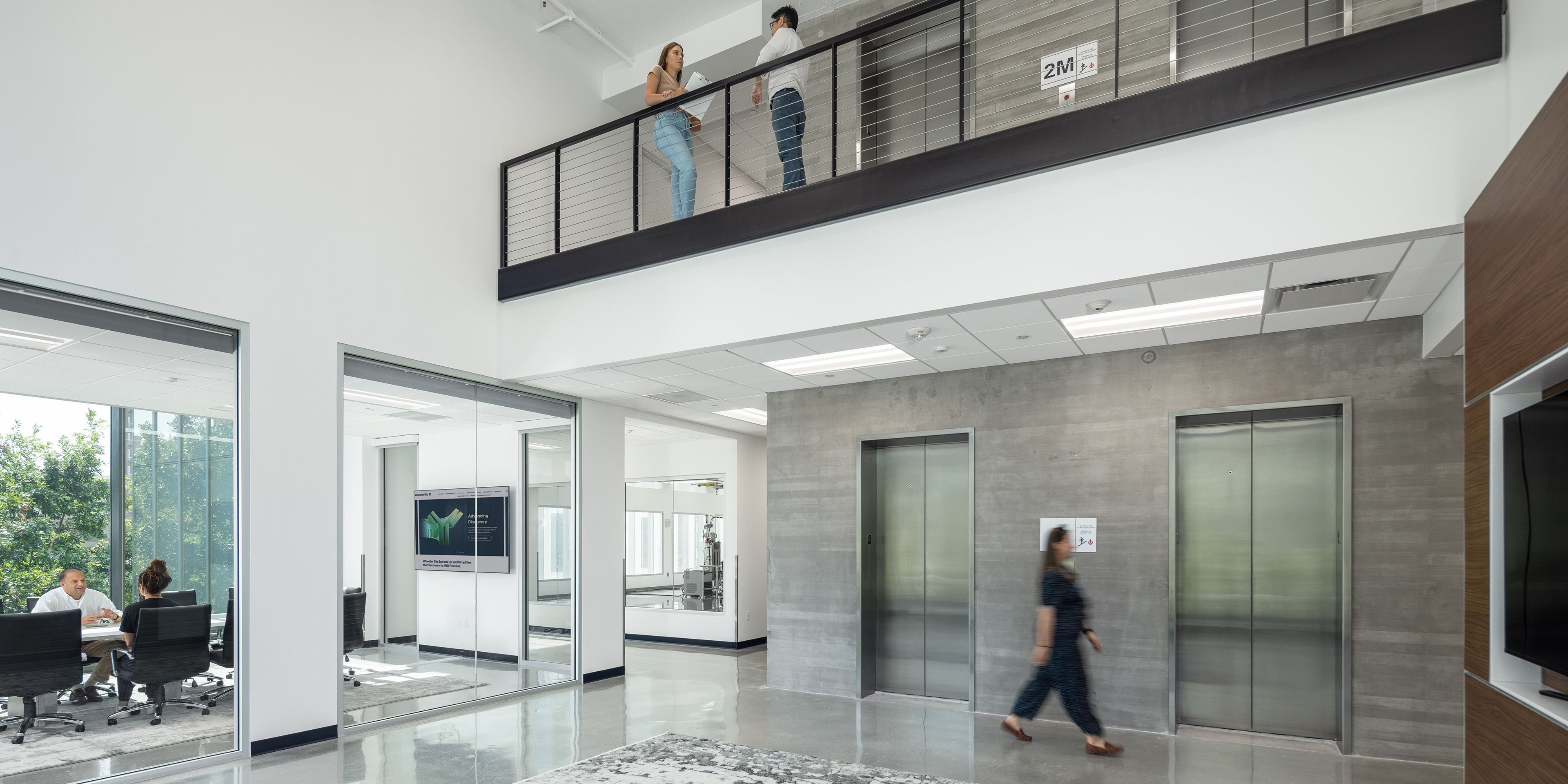
CDMO embraces ballroom design using closed processing for its manufacturing facility
Wheeler Bio is a biomanufacturing pioneer founded by Oklahoma City investor Christian Kanady and scientist entrepreneur Dr. Jesse McCool. Together, they had a vision of building an agile, phase-appropriate, smart factory with a team of industry experts and strategic investors. Their goal? To raise the industry-wide bar in biologics development and manufacturing services to help innovators reach clinical milestones faster.
To make their vision come to life, Wheeler Bio partnered with CRB to design their 35,000-square-foot facility. Housed in the ultra-modern Ziggurat building located in downtown Oklahoma City, the GMP facility is designed for clinical drug substance manufacturing of mAbs and other recombinant proteins.
Project Details
Client
Wheeler Bio
Location
Oklahoma City, OK
Square Footage
35,000
Assessing risk based on current science
Wheeler was determined to try new ideas and evaluate them based on science, data, and risk. The project team decided to follow the science, act on proper risk analysis, and blaze new trails. Guided by CRB and an expert leadership team with deep industry knowledge and familiarity with regulatory requirements and guidelines, they set out to analyze risks in Phase 1 clinical manufacturing with fresh eyes.
To offer speed to clinic, flexibility, and maximized manufacturing availability, our team conducted a comprehensive process closure analysis (PCA). This analysis allowed the team to understand the potential risks of contamination and mix-ups while running multiple products simultaneously within the same production suite. The assessment produced a list of mitigations that were subsequently incorporated into the design of the facility.
In addition to the PCA, the project team instituted various process risk assessments (pFMEAs), evaluating the potential operational risks and mitigations. The outcomes were also incorporated into the facility’s commissioning and qualification strategy, standard procedures, and batch records. Altogether, they formed the foundations of its phase-appropriate quality system.
Designed for flexibility and fast turnarounds
Since early-phase drug development is all about a fast turn rate, Wheeler’s business model and facility design aim to maximize its manufacturing availability and flexibility.
Positioning themselves as a boutique CDMO, Wheeler Bio set out to build a “Facility of the Future” designed to be highly flexible and accommodating of a variety of biologics. Embracing the principles of Pharma 4.0TM, Wheeler wanted its manufacturing facility designed around:
- Equipment connectivity
- Scalability
- Automation and digitalization
- Data transparency
- Process transferability
Wheeler Bio asked CRB to create a design that would accommodate highly flexible processes and fast turnaround times.
A “Zig”, then a zag
Right from the start of the design process in July 2021, the design team faced a challenge: how to retrofit an existing non-manufacturing space (originally intended as a mixed-used space for an oil and gas company) for GMP manufacturing and lab space.
Originally, the facility was slated to occupy the fourth and fifth floors of the Ziggurat, referred to locally as “The Zig.” With very limited space between structures and no two floors, structural bays, or ceiling heights quite the same, this presented a huge challenge to CRB’s architects, and engineers. In October 2021, after the original design was complete, the Wheeler team was notified by the landlord that they needed to move down to the second floor and mezzanine overlooking it, an area originally designed as an auditorium. This late-stage call triggered an immediate re-design, but the area’s larger square footage and taller ceilings also opened new possibilities of installing larger bioreactors (originally designed for 250 L) at 500 L scale.
An open ballroom approach
Wheeler capitalized on the latest innovations in cleanroom concepts allowing for exceptional agility to best serve the needs of early clinical phase developers. Based on the previously executed risk assessments, the design team created a ballroom facility with all the single-use equipment in the same production suite.
An open ballroom approach allowed Wheeler Bio to:
- Right-size their processes
- Run multiple products simultaneously
- Increase throughput
- Build in long-term flexibility
- Create cross-training opportunities
- Lower operational costs for client savings
Wheeler’s open ballroom houses equipment that is closed and set up for aseptic processing. Therefore, the room itself doesn’t need to be classified as a higher-grade space. This makes it more “time” efficient with less rigorous gowning requirements and less travel time and waiting time in between areas. It also translates into significant cost and energy savings, since Grade D production spaces require fewer air changes, need less filters and use smaller air handlers.
Within the ballroom, Wheeler Bio incorporated smaller subrooms with biosafety cabinets (BSCs). These Grade C inoculation prep rooms provided highly controlled spaces for processes like shake flask inoculation and cell expansion. Pass-throughs were installed in between the Grades C and D spaces to provide a controlled and efficient means of material transfer. This unique approach means that Wheeler doesn’t require separate teams for upstream, downstream, media prep, etc. Instead, all team members are cross trained on all aspects of the process. Additionally, this combination of closed and open processes translates into cost savings while providing safe, controlled environments as needed throughout the upstream and downstream processes.
The finished facility
Overall, the design of open ballroom production suites, digital system integrations, single-use technologies, and strategic partnerships—combined with a proper risk management program and a phase-appropriate quality system—allow the facility’s operations to be in a consistent state of control. The lower capital and operating expenses mean fewer barriers to access for clients.
In their quest to accelerate the path from discovery to IND filing, Wheeler Bio built a facility that maximizes flexibility and availability while lowering costs for clients. Designed with a risk-based approach, it uses an open ballroom and single-use manufacturing strategy. It offers ultra-modern and digitally connected equipment and is building a local workforce to sustain the future biomanufacturing ecosystem. Through smart partnerships, the new facility connects drug developers on the coasts and offers integrations with CROs’ discovery services. All this combined means a low-cost and accelerated model for translating innovation into clinical impact.



